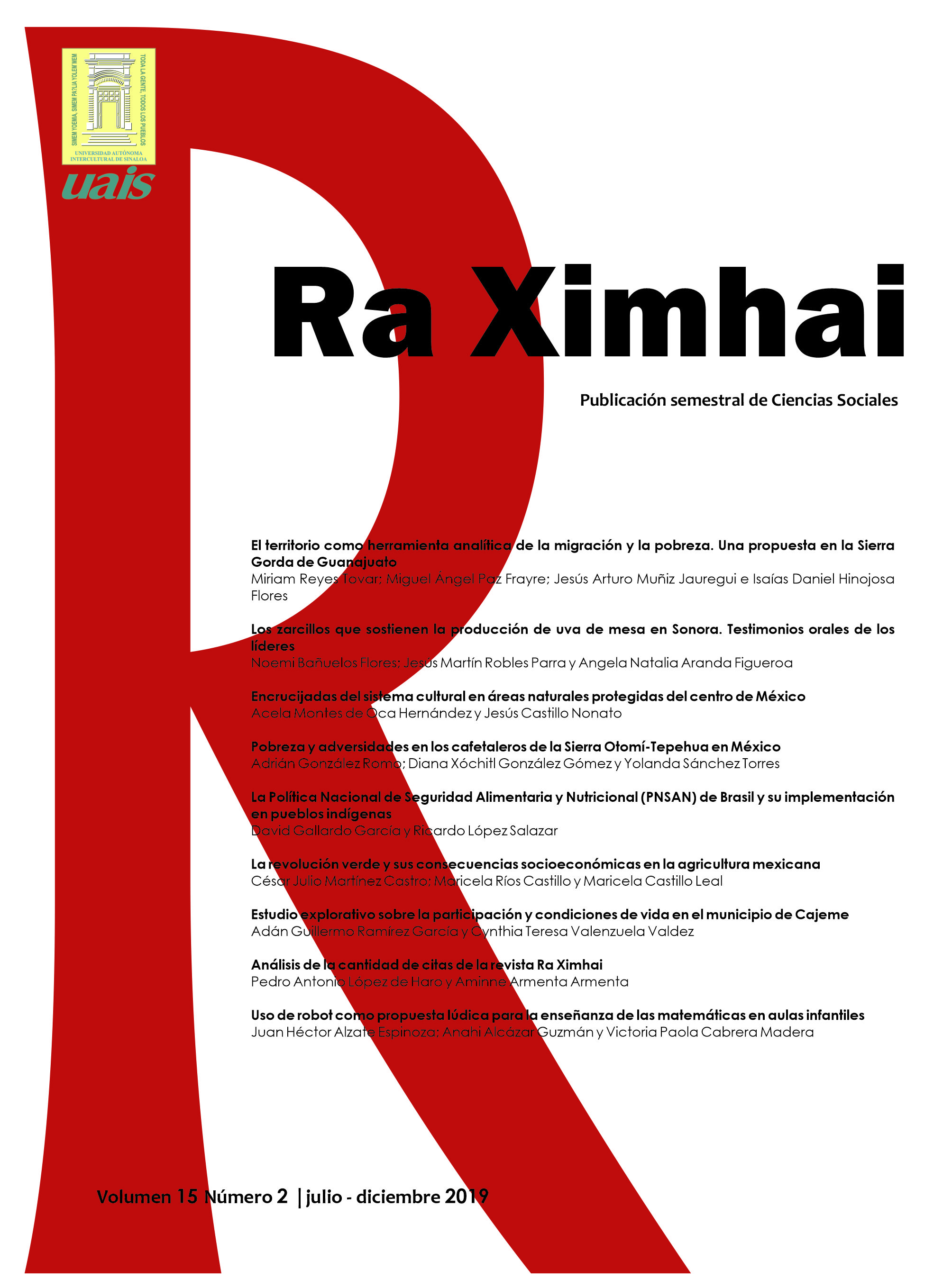Analysis of the number of citations of Ra Ximhai journal
DOI:
https://doi.org/10.35197/rx.15.02.2019.08.lpKeywords:
Ra Ximhai, citations, impact, revisionAbstract
The following is an exploratory study regarding the scientific impact of the Ra Ximhai journal, using the number of citations it has obtained as a metric. The scientific journal Ra Ximhai is a biannual publication run by the Universidad Autónoma Intercultural de Sinaloa, which has been published in print and digital versions since 2005. It is indexed in the Master Journal List, Redalyc, Latindex, among others. A study of its citations was carried out in order to know the impact of its publications in the scientific community to date. Information about the number of citations of the articles in the Ra Ximhai journal was collected through Hazarding's Publish or Perish 6 program, which collected information from Google Scholar. A total of 14 searches were carried out, one per year, from 2005 to 2018, showing a total of 935 documents, including multidisciplinary scientific articles and reviews. A total of 5431 citations were obtained and the most cited article up to the date of the search had 241 citations. Some descriptive statistics and a Pareto analysis are shown, which shows that the most cited articles of the journal are those with more than 8 citations. The specific bibliometric analysis of the Ra Ximhai journal will help as a starting point to continue research on the subject, compare the results with other scientific journals on the same subject and as a diagnosis of the current situation of the journal.
Downloads
References
Bladek, M. (2014). DORA: San Francisco declaration on research assessment (May 2013). College & Research Libraries News, 75(4), 191-196.
Brown, L. D., y Gardner, J. C. (1985). Using citation analysis to assess the impact of journals and articles on contemporary accounting research (CAR). Journal of Accounting Research, 84-109.
Doreian, P. (1988). Measuring the relative standing of disciplinary journals. Information Processing & Management, 24(1), 45-56.
García, E. G. (2008). La experiencia educativa de la Universidad Autónoma Indígena de México. Índice de la Publicación, 349.
Garfield, E. (1987). 100 citation classics from the Journal of the American Medical Association. Jama, 257(1), 52-59.
Garfield, E., y Merton, R. K. (1979). Citation indexing: Its theory and application in science, technology, and humanities (Vol. 8). New York: Wiley.
Harzing, A.-W. (1997-2009). HARZING HOME. Citado el 27 de mayo de 2019 de HARZING COM: http://www.harzing.com/index.htm
Johnson, J. L., & Podsakoff, P. M. (1994). Journal influence in the field of management: an analysis using Salancik's index in a dependency network. Academy of Management Journal, 37(5), 1392-1407.
Pierce, S. J. (1990). Disciplinary work and interdisciplinary areas: Sociology and bibliometrics. Scholarly communication and bibliometrics, 46-58.
Repanovici, A. (2010). Measuring the visibility of the university’s scientific production using google scholar, Publish or Perish software and Scientometrics. In World library and information congress: 76th ifla general conference and assembly. Gothenburg (pp. 1-15).
Small, H. (1982). Citation context analysis. Progress in communication sciences, 287-310.
Wertsch, James V. (1995), “Sociocultural Research in the Copyright Age,” Culture & Psychology, 1 (Marzo), 81–102.
Downloads
Published
How to Cite
Issue
Section
License
Copyright (c) 2019 Pedro Antonio López de Haro, Aminne Armenta Armenta

This work is licensed under a Creative Commons Attribution-NonCommercial 4.0 International License.
Usted es libre de:
- Compartir — copiar y redistribuir el material en cualquier medio o formato
- Adaptar — remezclar, transformar y construir a partir del material
- La licenciante no puede revocar estas libertades en tanto usted siga los términos de la licencia
Bajo los siguientes términos:
- Atribución — Usted debe dar crédito de manera adecuada , brindar un enlace a la licencia, e indicar si se han realizado cambios . Puede hacerlo en cualquier forma razonable, pero no de forma tal que sugiera que usted o su uso tienen el apoyo de la licenciante.
- NoComercial — Usted no puede hacer uso del material con propósitos comerciales .
- No hay restricciones adicionales — No puede aplicar términos legales ni medidas tecnológicas que restrinjan legalmente a otras a hacer cualquier uso permitido por la licencia.








